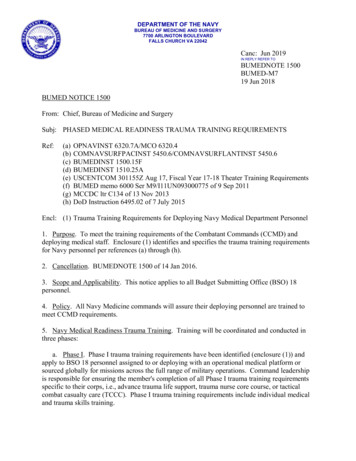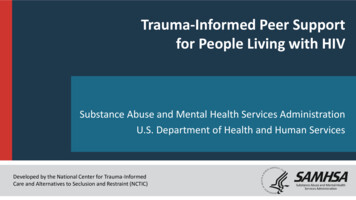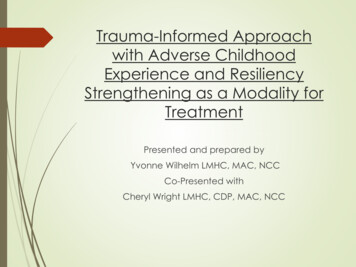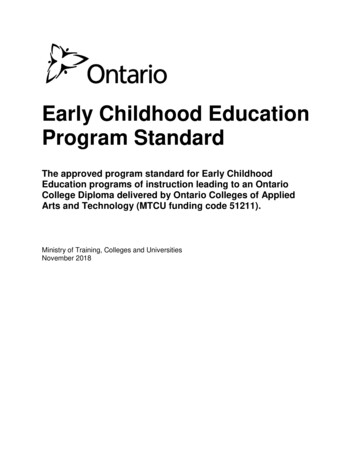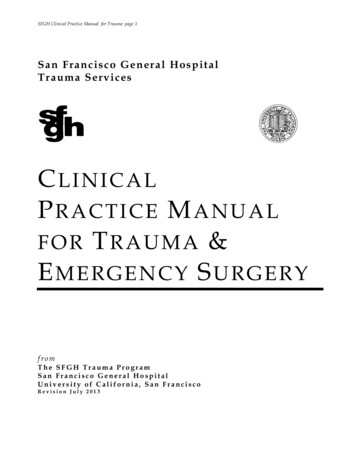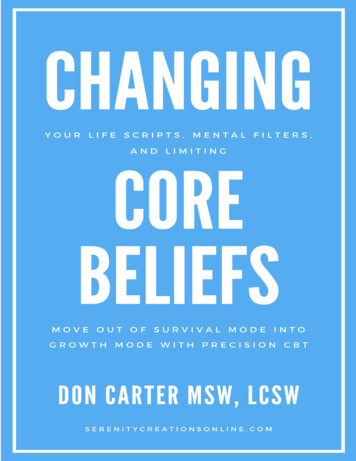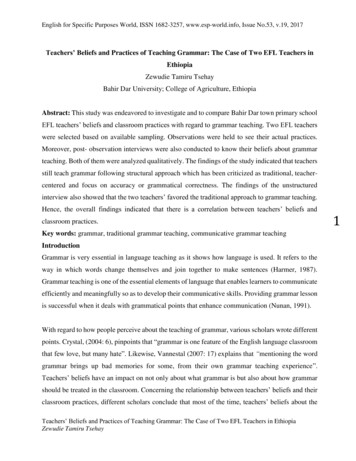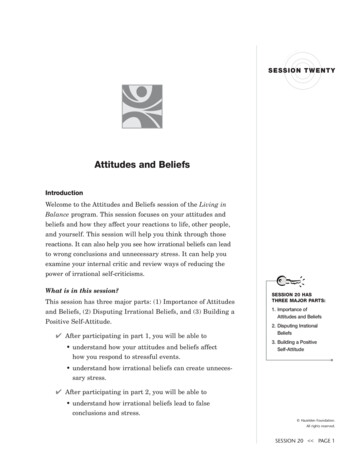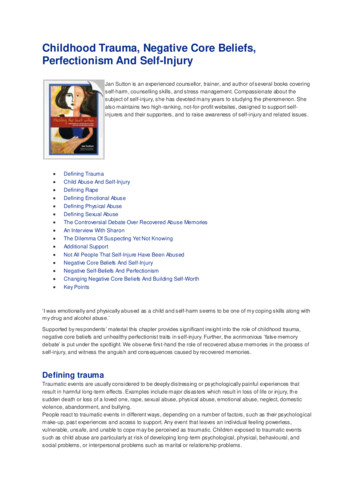
Transcription
Childhood Trauma, Negative Core Beliefs,Perfectionism And Self-InjuryJan Sutton is an experienced counsellor, trainer, and author of several books coveringself-harm, counselling skills, and stress management. Compassionate about thesubject of self-injury, she has devoted many years to studying the phenomenon. Shealso maintains two high-ranking, not-for-profit websites, designed to support selfinjurers and their supporters, and to raise awareness of self-injury and related issues. Defining TraumaChild Abuse And Self-InjuryDefining RapeDefining Emotional AbuseDefining Physical AbuseDefining Sexual AbuseThe Controversial Debate Over Recovered Abuse MemoriesAn Interview With SharonThe Dilemma Of Suspecting Yet Not KnowingAdditional SupportNot All People That Self-Injure Have Been AbusedNegative Core Beliefs And Self-InjuryNegative Self-Beliefs And PerfectionismChanging Negative Core Beliefs And Building Self-WorthKey Points‘I was emotionally and physically abused as a child and self-harm seems to be one of my coping skills along withmy drug and alcohol abuse.’Supported by respondents’ material this chapter provides significant insight into the role of childhood trauma,negative core beliefs and unhealthy perfectionist traits in self-injury. Further, the acrimonious ‘false memorydebate’ is put under the spotlight. We observe first-hand the role of recovered abuse memories in the process ofself-injury, and witness the anguish and consequences caused by recovered memories.Defining traumaTraumatic events are usually considered to be deeply distressing or psychologically painful experiences thatresult in harmful long-term effects. Examples include major disasters which result in loss of life or injury, th esudden death or loss of a loved one, rape, sexual abuse, physical abuse, emotional abuse, neglect, domesticviolence, abandonment, and bullying.People react to traumatic events in different ways, depending on a number of factors, such as their psychologicalmake-up, past experiences and access to support. Any event that leaves an individual feeling powerless,vulnerable, unsafe, and unable to cope may be perceived as traumatic. Children exposed to traumatic eventssuch as child abuse are particularly at risk of developing long-term psychological, physical, behavioural, andsocial problems, or interpersonal problems such as marital or relationship problems.
Child abuse and self-injuryNumerous studies have found a positive correlation between child abuse and self-injury (see for example:Fava zza & Conterio, 1989; van der Kolk, Perry, & Herman, 1991; Arnold, 1995; Hawton, et al; 2002). Eighty-four(84%) percent of the respondents who completed the survey for Healing the Hurt Within, 1st edition (Sutton,1999) reported childhood trauma/other childhood circumstances as contributory factors to their self-harm. Severalreported multiple forms of child abuse (emotional, sexual, physical, neglect and rape).‘As a child of 7 years old I was sexually, physically, emotionally abused and raped, while living with mygrandparents. I always have felt “dirty, guilty and unworthy”. My mother instilled into my memory that I was a “bigmistake” and that “I happened”, much to her regret. I hate myself and I always feel nothi ng but self-destructtowards myself and feel I shouldn’t be here.’‘My father and grandfather were abusing me. I cut because I want the outside to show how I feel on the inside;because I feel I deserve it; because life without abuse is so unfamiliar it’s terrifying; because if I don’t cuteveryone will decide I’m OK now and leave me alone, and I’m not OK.’‘I remember the first time I cut myself. I was 12. My older brother had raped me, and I couldn’t find any other wayto express my anger.’‘I was very insecure, having had traumatic events in my early childhood, resulting in me being separated from mymum for 3 months. Also when I was older several family members died in a short time (2 years). I have low selfesteem. I was at one time (as an adult) sexually abused, also raped once. I have a much happier life now but I’mstill very insecure.’Defining rapeFigure 6.1 gives a definition of rape provided by the Crown Prosecution Service. Definitions of abuse are providedlater in the chapter.Defining emotional abuseEmotional abuse is subtle – it comes in various guises and because there are no visible wounds or scars it isdifficult to detect. Emotional abuse damages children’s self-concept, and leaves them believing that they areunworthy of love and affection. Emotional abuse is invariably present in all types of abuse, and the long -termharm from emotional abuse can be equally, if not more damaging, than other forms of abuse.‘I know I self-harm mainly because I have so much self-hate – I see so much beauty in others, but never myself!Two years ago it came out that I was sexually abused as a child and logically I know this is probably a
contributing factor to my self-harm – but I find it hard to accept and admit. Due to the feelings of worthlessness Iwant it to be my fault!’Emotional abuse goes beyond the realms of the spokenOther terms used to describe emotional abuse include verbal abuse, and mental or psychological abuse. Figure6.2 provides examples of emotional abuse.Verbal abuseA torn jacket is soon mended;but hard words bruise the heart of a child.—Henry Wadsworth LongfellowWhoever invented the maxim, ‘Sticks and stones may break my bones, but words will never hurt me’ wasmistaken. Constant verbal insults and harsh criticism cut deep, name calling wounds, teasing or spitefulcomments hurt. Verbal abuse can stick like glue, leaving deep and long -lasting invisible mental scars that canimpact on a child’s emotional or social development. Children that live with criticism internalise those beliefs aboutthemselves and often become self-critical. Valerie Sinason (2002) in her excellent book Attachment, Trauma andMultiplicity succinctly sums up the damaging consequences of verbal abuse:What happens when a child has to breathe in mocking words each day? What happens when a parent, anattachment figure utters those words: someone the child needs in order to emotionally survive? Sometimes, thatmocking voice gets taken inside and finds a home. It then stays hurting and corroding on the insi de when theoriginal source of that cruelty might long ago have disappeared or died. (p. 4)Clarifying the difference between emotional abuse and neglectNeglect is another insidious form of abuse. In essence, neglect means a child’s basic needs are not m et, forexample: love, care, nurture, comfort, warmth, a safe environment, food, somebody being there for the child.Figure 6.3 gives a definition of neglect provided by NSPCC.
Defining physical abusePhysical abuse is characterised by inflicting non-accidental injuries, physical punishment, or violence on a childthat results in harm or even death. Figure 6.4 gives examples of physical abuse and the range of severity.‘I self-harm because I was abused sexually, physically, emotionally and spiritually as a child. It somehow helpedme cope, and was also a way to vent the self-hate I was given by the abusers, which I turned in onto myself. Selfharm was a way of controlling torture.’‘I know now I self-harm to relieve the pressure I’m under due to my childhood where I was sexually and physicallyabused for 12 years. Also my Granddad, who was a father figure to me died, and that was a great loss to me.’Defining sexual abuse‘[Self-injury] stems from 16 years of sexual abuse by my father.’Sexual abuse ‘can be defined as the involvement of a young person who has not reached intellectual andemotional maturity, in any kind of sexual activity imposed upon them by any person who is more powerful byreason of their age or their position of authority, that violate the social taboos of family roles, or that break thelaw.’ (Breaking Free: Source, Sutton 1999:61) Figure 6.5 gives a further definition provided by ChildLine.Child sexual abuse and self-injury
Child abuse provides fertile ground for the development of a range of adverse effects that can impede healthyadult functioning (see Figure 6.6 Child abuse: Potential adverse long-term effects). Self-injury is one, among aplethora of strategies that some (but not all) survivors use to cope.‘I’ve recently started to accept the connection between being sexually abused as a child and the feelings that self harm helps to release.’‘I’d had 12 years of abuse – physical, mental, emotional and sexual (voyeurism) by a psychopathic stepfather,who controlled my life and who I despised. Initially it [self-harm] was to blunt my impotence and feelings of anger.’
The aftermath of child sexual abuseThe following two pictures, The legacy of child abuse by Sian (Figure 6.7), and Child/Woman by Sheelah. (Figure6.8) demonstrate clearly the aftermath of child abuse.
The woman is black and white with a small hand, symbolising how she feels she must appear/was made toappear. Clear-cut. However, the little hand expresses her hidden vulnerability. The child is in colour (see coverpicture for coloured version) with a searching, knowing, eye. The large hand is severely adult with painted nails,showing how the hand was used for adult purposes. Her skin is drawn and aged, the burden of feeling old beforeher time. The bow in the pigtail . . . poignant in that it is the only childlike thing apparent.Telling but not being believedSeveral incest survivors who self-injure as a consequence of their experiences reported disclosing the abuse to aparent or another family member. In one case, a respondent reported that her disclosure to her mother that herfather was abusing her had been met with denial and an accusation of ‘False Memory Syndrome [FMS]’. FMS isdiscussed later in the chapter. The same respondent pointed out that ‘Somehow my mother’s denial had thepower to devastate me in a way that recovering of memories hadn’t.’ Another respondent wrote: ‘I believe that theunderlying reasons for my self-harm are because I was sexually abused by my father and brother – and becausemy family don’t know whether to believe me.’The psychological wounds that result from telling about abuse a nd not being believed cannot be underestimated,especially if the person confided in is a parent or other close relative. Being disbelieved by one’s mother, who istypically the child’s primary attachment figure, nurturer, and safety anchor, is tantamount to additional trauma – itnot only adds fuel to the sense of betrayal the child already feels, it can leave the child feeling ashamed, guilty,helpless, fearful, isolated, and struggling to cope alone without a safety net.Why don’t mothers believe?There are numerous reasons why mothers choose not to believe. The reasons are mainly rooted in fear – hereare a few examples: Fear of shame being brought on the family.Fear of the family being torn apart.Fear of partner going to jail.Fear of the financial implications.Keeping silent about abuseThe following picture by Erin (Figure 6.9) illustrates why she kept silent about the abuse, and how she struggleswith issues of trust in the wake of her experience.
Why don’t children tell?There are numerous reasons why children don’t speak up about child abuse – these include: Assuming responsibility for the abuse (‘it must have been my fault’; ‘I must be a bad girl/boy’; ‘there must be something wrong with me’) – blaming oneself is a common thread among abuse survivors.Not being aware that abuse is wrong (‘this must be what all Dads/Mums do’).Liked the special status and attention (‘Daddy only does it because he loves me’).Fear of not being believed or the consequences of telling (getting into trouble or getting the perpetratorinto trouble).Intimidation by the perpetrator (‘something bad will happen to you if you tell’; ‘you must never tell anyone– it’s our special secret’), or enticements to maintain the secret.Shame, embarrassment and guilt (e.g. if sexually stimulated or aroused by the abuse).Lacking in verbal skills to explain the abuse in words (e.g. if the abuse happened during the child’spreverbal years).The relief of tellingThe next picture ‘Lifting the secrecy cloud’ by Sheelah (Figure 6.10) exemplifies the relief and sense ofempowerment that comes from breaking the secrecy about abuse to a professional or others who are willing tohear.
The controversial debate over recovered abuse memoriesThe notion that memories of child abuse can be forgotten, and then years later be remembered, sparked a bitterdebate among some professionals in the early 1990s. According to Alan W. Scheflin (1999) ‘The recoveredmemory debate has been the most acrimonious, vicious and hurtful internal controversy in the history of modernpsychiatry.’ Supporters of False Memory Syndrome (FMS), mainly drawn from the ranks of accused parents,question the validity of recovered memories of childhood abuse, arguing that naïve and overzealous therapistsare responsible for encouraging or implanting false memories of child abuse in their clients’ minds via the use ofsuggestive techniques. They particularly take issue with hypnosis, yet also question many other therapeuticpractices such as: Guided imageryCreative visualisationSuggestive questioningFree associationDream interpretationDeep relaxationRecommending survivors’ literatureSurvivor support groupsLooking at childhood photographs
Bibliography work.Defining False Memory SyndromeFalse Memory Syndrome is defined as ‘[A] condition in which a person’s identity and interpersonal relationshipsare centered around a memory of traumatic experience which is objectively false but in which the person stronglybelieves.’—Kihlstrom (1996)Those in the opposing camp, mainly researchers who believe in repression and dissociation, and practitionersworking in the field of child abuse, argue that it is possible to ‘forget’ then later remember abuse. Moreover, asJennifer Freyd, a researcher into memory, and professor of psychology at the University of Oregon, in hermilestone book, Betrayal Trauma: The Logic of Forgetting Childhood Abuse (1996) hypothesises:There are several good reasons why real memories of abuse may arise in the context of th erapy. Therapy mayprovide the first opportunity for a person to feel safe enough to remember the abuse; the therapist may be the firstperson to ask the client about abuse; and the client may have sought therapy because of memories just beginningto emerge, which are causing emotional crisis without explicit understanding of the source of the crisis. (p. 55)The False Memory Syndrome Foundation (FMSF, 1998–2007)Pamela Freyd, Jennifer Freyd’s mother, supported by a scientific advisory board of distinguish ed professionals,established the False Memory Syndrome Foundation (FMSF) in Philadelphia in 1992 (Hacking, 1995:122 –123),following an accusation by Jennifer, that her father Peter Freyd had molested her as a child (an accusationvehemently denied by Peter and Pamela). Hacking, a University Professor of Philosophy, and author of Rewritingthe Soul: Multiple Personality and the Sciences of Memory, writing in provocative manner sums up the aims of theFMSF:The foundation is a banding together of parents whose adult children, during therapy, recall hideous scenes offamilial child abuse. Its mission is to tell the world that patients in psychotherapy can be brought to seem toremember horrible events of childhood that never happened. Distressed thirty-somethings (and up) believe thatthey were abused by parents or relatives long ago. But, urges the foundation, many of the resulting accusationsand subsequent family chaos result not from past evils but from false memories engendered by idealogicallycommitted therapists. (p. 121).The British False Memory Society (BFMS, June 11, 2007)The British False Memory Society formed in 1993 with similar aims to its counterpart: to raise awareness of thecontroversial concept of ‘recovered memory therapy’ and support fam ilies of those falsely accused of abuse.While I contest many of the assertions put forth by the false memory societies, they have at least drawn attentionto the fallibility of human memory and the need to tread extremely cautiously when working with clie nts whorecover abuse memories during the process of therapy.(For information on therapeutic precautions to help prevent false memory syndrome see Chapter 12, Guidelinesfor those working with self-injury and related issues).The relationship between recovering memories of abuse and selfinjuryThe three case studies, interview, and poem that follow highlight the relationship between recovering abusememories and self-injury, and the terrible dilemma people face when they have unclear memories, and noevidence to corroborate the belief that they have suffered abuse. You will also see that with the right support andhelp, and against seemingly insurmountable odds, healing from self-injury is possible.Case study 6.1: Jill (1)Two Jill’s stories are included in this section. To avoid confusion I have referred to them as Jill 1 and Jill 2.I am 46 years old. I wrote the piece below about two years ago. As I mention in the writing my self-harm hadstarted again and unfortunately escalated to a level where I needed to be in hospital for my own safety. I didn’t getwell in hospital, in fact I deteriorated. My therapist was aware of a Therapeutic Community and after a period of
assessment, I moved in. The experience in the Community has changed my life. I no lo nger self-harm andthrough therapy have come to accept what happened to me and move on. I have recentl y moved out and I amslowly returning to work and rebuilding my life.All my life I ha ve known something was not right due to quite specific fears I had. I have been in therapy for 18months so far. After about five months of therapy I started to get images – they made no sense to me but I wroteabout them creatively. This carried on for the next eight months or so, after which I began to get more specificimages. My self-harm had returned (I had stopped in my late 20s) and I was aware that I wasn’t able to ‘block’ theimages/fears.My therapist was aware for a long time that whenever I got close to anything I would block it (dissociate). I wouldalso avoid eye contact with her so she couldn’t wear down my defences. She never once mentioned abuse, usingonly my word – ‘hurt’. I asked her if she believed me, she said yes. I also asked her if she thought I could haveimagined it. She replied that this was possible but unlikely because my physiological responses were quiteintense.I am desperate for ‘evidence’ and I am not sure what I need to help me to accept my images. I have alsoexperienced pains in places where ‘the child’ has been hurt (in the images). My therapist says my images arememories.I am at the stage where I cannot ignore the fact that I may ha ve been hurt, however, I am desperately seekingsomething to disprove it. I have felt as though I am going mad. How can the images seem so real when I have nomemory of them happening? Although the images are now much clearer, I think I have always had a sense thatsomething happened to me. I don’t want the memories to be true and want to believe in FMS [false memorysyndrome] but deep down, I do believe what I ‘see’.I am fighting the process. I am faced with overwhelming emotions I can’t deal with. Cutting helps but it is not aseffective as it used to be; it doesn’t give me the same relief. Sometimes I think I am aware of flicking in and out ofdissociation as I try to block the painful images. It is a very confusing, scary time.Jill 1: Observations from case studyDid you notice that Jill had always sensed something was wrong, and how she had managed to stop self-harmingin her late 20s, but had started again during therapy? Did you absorb that she started getting images in therapyand that over time these images became more specific, or how when things got too close for comfort with hertherapist she tried to push them away, and avoided eye contact?Did you note that her therapist never once mentioned the word abuse, yet acknowledged Jill’s belief that she hadbeen ‘hurt’? Furthermore, are the physical pains Jill experienced bodily memories? And what about herdesperation for evidence that something happened on the one hand, yet on the other, desperation to findsomething to disprove it – did you pick up on that? Did you also take in the important fact that Jill no longer selfharms? What stuck out most in your mind from reading Jill’s case study?Case study 6.2: Jill (2)Jill’s story illustrates clearly the association between returning abuse memories and self-injury, as well as theagony she went through before help and support was forthcoming. Note too that like her counterpart above, Jillhas healed from self-injury.It is now almost two years since I last self-injured, although I still occasionally experience the urge to do so. Astime goes by the urge has become much less intense and no longer dominates my mind. It has though left mewith a strong desire to try and help others understand why some people should need to hurt themselves at times.It is fast becoming recognised that self-injury covers a wide range of ways in which a person may inflict harm onthemselves, but I can only tell of what I did to myself and what drove me to do so. Looking back over the years Isuppose my many attempted overdoses and drownings could be classed as self-harm in the most general sense,although not intentionally so. Although at the time I wanted to end my life, in retrospect I think it was more to dowith escaping or trying to cut off from a life and memories that I was struggling to cope with. In desperation thismade me feel that I wanted to die, yet deep down I was so terrified of dying and death that I find it hard to believethat I could have wanted to die. Instead I think I yearned for a state of deep sleep, one from which I might awakeinto a different world free of my previous fears, panics, anxiety, memories and the awful suffocating blackdepression.Throughout my life, at different points, from my late teens to my late forties just a year or two ago, I would turn tothose means to escape from a terror I could not understand. Over the years until very recently these attempts to
escape were met with mockery, ridicule, cold dismissal and extreme criticism. The general medical view appearedto be that I was ‘attention-seeking’, and therefore not seriously contemplating or capable of suicide. It still bafflesme why anyone could believe that anyone would want the sort of dismissive attention that the general medicalprofession usually gives you after failed suicide attempts. My over-riding memory after so-called attempts wasalways deep despair and regret that I had failed to blot out the awfulness of my life. Th is combined with theshame, self-disgust and guilt that overwhelmed me, makes me wonder now why I still did it over and over again.The urge afterwards was always to run away and hide, something else that took over me frequently in times ofanguish.Yet until four years ago I had not actually hurt myself physically and deliberately by cutting. Then suddenly Ibegan to experience overwhelming urges to cut myself with razors, knives or anything sharp and pointed enoughto cause me sufficient pain to block out the inner pain and turmoil that was driving me mad inside.A flood of recovered memories of years of sexual and emotional abuse by my father, starting from when I was asyoung as four, was the catalyst for my ‘cutting’. Time after time I tried to blot awa y the ‘horridness’ inside mewhich to this day feels as scary as it did then; as well, as then, there seemed to be no relief from it. Until that isthe day when I suddenly found that by cutting, scratching, tearing or stabbing with knives, scissors, razors ,anything – I could momentarily blot out the hurt inside of me. My cuts dug anywhere but especially in those veryprivate places where the pain and the memory is the worst.It felt that by concentrating very intensely on creating this other hurt I was able to blot out the deeper and moreterrible pain: the relief was only momentary, but so, so welcome. For that very brief time I felt in control and hadgained some temporary release from the constant jangling tension, terrifying panic and searing pain inside myhead and body.For more than two years I successfully self-injured in secret and managed to hide my wounds and scars. Thenone day I was ‘found out’ by a very understanding GP who treated me with kindness and patience. Sadly thoughhis best intentions for my care led me to stay on a psychiatric unit where unfortunately the staff responded in amuch less empathic way and at times openly critical manner. The system in this unit for dealing with high -riskpatients was to place them under constant supervis ion.Forcible restraint was their usual answer to any attempt to self-harm and their only method of trying to prevent myurges was to occupy me with constant activities; if all these failed and I succeeded in evading their ever watchfuleye to hurt myself, then I would be given a very stern and at times very angry telling off. Somehow though thisnever deterred me, instead it just seemed to increase my need and determination to hurt myself; it was as if oncethe urge was there I had to do it come what may.The turning point came during that spell of hospitalisation when my psychologist ever so gently asked me why Ihad needed to hurt myself; as she held my hand and listened I was able to slowly tell her. From then on, and withthe help of my GP, she devised a pattern whereby I gradually felt able to seek my GP’s help at times when thedistress was intense and overwhelming. The very first time I summoned the courage to make that call to my GPhe responded immediately and was full of praise that I had been able to do so. I still remember how kind he wasthat day, how he sat and listened without condemning, but really seemed to understand. How reassured andsuddenly safe I felt when he offered me a cup of tea in his surgery.There hasn’t always been success since then – at times the urge would totally overwhelm me, but I never lost thesupport and encouragement of my GP and psychologist. They helped me to recognise the trigger points for theseurges. Times when I was feeling panicky or ‘out of this world’; when th e urge to run was overwhelming; timeswhen the memories of my past abuse were particularly vivid and real and accompanied by my screams of terror; ifI was alone, frightened, in pain or desperately needing comfort; when I yearned to cry but couldn’t; when I felttotally worthless, unvalued and the future looked bleak; but especially when I felt threatened and in danger.Together we explored where these urges came from and talked of how I could divert the pain away from myself.A suggestion by my psychologis t to keep a diary as a way of me broaching previously unspoken thoughts,feelings and memories, proved to be another major turning point for me. Writing has helped me enormously since;those early jottings down evolved into poems that tumbled out in a torrent of blunt and hurt words.Then as I wrote more I began to read and started looking for articles about others who had suffered similar abuseto me. One book had a particular impact on me, Breaking Free: Help for Survivors of Child Sexual Abuse, bypsychologists Carolyn Ainscough and Kay Toon (2000). It made me realise that I was not alone in experiencing allmy frightening panics and weird symptoms that I had once thought were just me going mad.For so much of my life I had felt so lonely and thought that no-one really understood or believed me. Now I hadhope and understanding and I finally began to believe that the memories might one day fade a little. But what
above all else has helped me was when people, such as my GP and psychologist, asked me what would help me,instead of them telling me what they thought would be best for me.As the months, then years, went on and people have helped me to be able to ask for help when I most needed it,and as the times increased when I was able to overcome the urges, I gradually came to realise that I was winningthrough. Of course there are hiccups, times when the memories were triggered again and the urge returned asstrong as ever before and I would feel out of control again. But now nearly two years after I last s uccumbed to theurge and realising that any sensation of needing to hurt myself is very infrequent, I am finally looking to the futurewith hope. As my memories begin to fade a little I now know that it has helped me to talk when the support wasright.Jill 2: Observations from case studyDid you notice that at times between her late teens and late forties Jill self-harmed in various ways to escape froma feeling of dread that she could not make sense of, yet didn’t start cutting until she was flooded with memories ofyears of sexual and em otional abuse by her father from a very young age? Did you observe how cuttingtemporarily brought relief from the awful hurt she felt inside, and how she managed to keep the behaviour asecret for two years? What about the accusations from the general med ical profession that she was attentionseeking and the punitive treatment she experienced while in ‘psychiatric care’? Did you note that a caringresponse from her psychologist was what started to turn things around for her? How her psychologist held herhand and sensitively enquired why she needed to hurt herself? And how with support from the psychologist andvalidation from her concerned GP, she slowly started to control the urges to self-injure? Furthermore, that bykeeping a diary, it enabled her to express the unspoken – her memories, thoughts and emotions, and being askedwhat she needed, rather than told what was best for her, brought solace and healing? What stuck out most inyour mind from reading Jill’s case study?Case study 6.3: LindaLind
still very insecure.' Defining rape Figure 6.1 gives a definition of rape provided by the Crown Prosecution Service. Definitions of abuse are provided later in the chapter. Defining emotional abuse Emotional abuse is subtle - it comes in various guises and because there are no visible wounds or scars it is difficult to detect.


